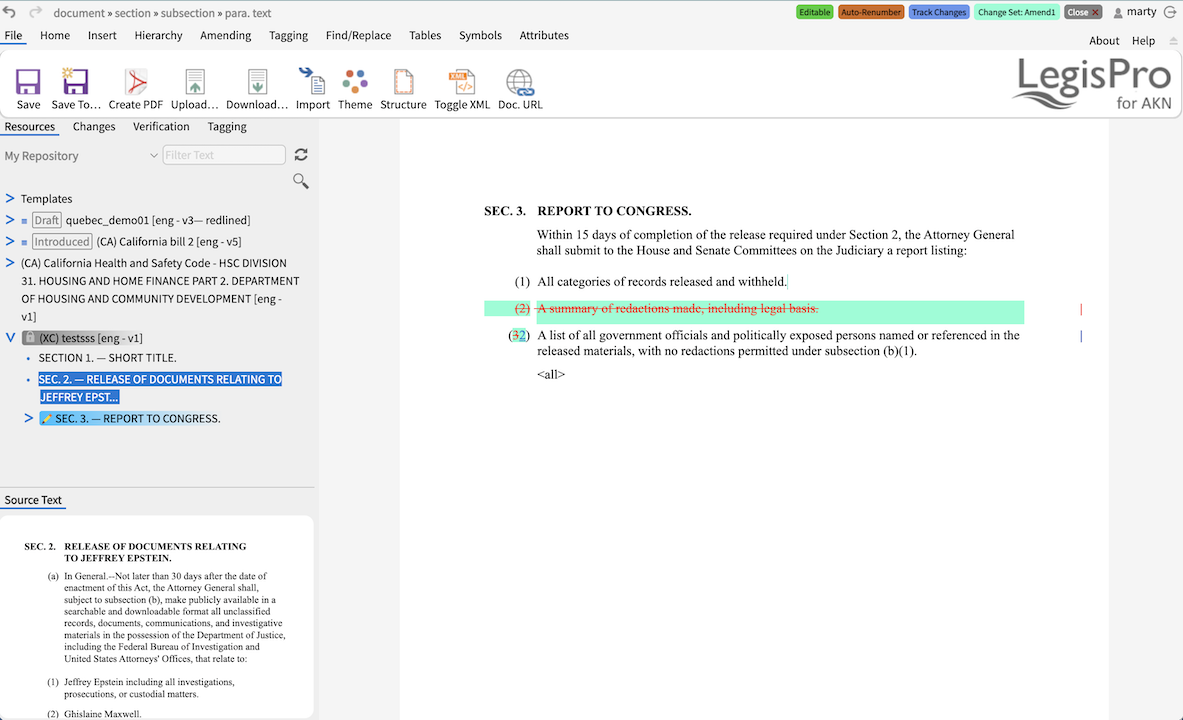LegisPro , Microsoft Word, and XML Modernization with Akoma Ntoso
November 19, 2025


Lawyers are very comfortable with MS Word. By the late 1990’s, MS Word had knocked out WordPerfect and continues to dominate the legal field 42 years after its release.
Data from the American Bar Association’s Legal Technology Survey Report consistently shows that Microsoft Word is used by approximately 98% of lawyers, highlighting its near-universal dominance as the baseline drafting tool in the legal industry.
But legislative drafting is not ordinary legal writing — it requires a different level of precision.
Legislative drafters (lawyers) have a highly specialized and technical job to do. The move to law as data has realized the benefits of precision, automation, and transparency; all things we value in well-run, democratic governments. The group of legislative and regulatory drafters for a parliament is often centralized or semi-centralized as a “Legislative Counsel”.
These counsels serve the citizens and elected members of a parliament. They are responsible for official bill drafts, amendments, secondary supporting documents, and ultimately consolidation of law. The use of a legislative counsel to draft bills is sometimes mandated and sometimes optional (depending on the parliament).
Legislative Counsels are modernizing. They are taking advantage of advances in technologies like Akoma Ntoso, process automation, and XML tools. Their drafting began to move to XML several years ago and they are using LegisPro, XMetal, or Arbortext.
Government technologists, who plan to modernize, face a dilemma: cling to Word for comfort, or risk leaving lawmaking behind in the digital transformation. The answer isn’t either/or — it’s integration.
Why the move to XML, instead of sticking to trustworthy MS Word?
You say “MS Word works fine - why change?”. After all, staff and lawyers are comfortable with Word; it’s fast, familiar, and already embedded in workflows.
MS Word is a presentation tool, not a semantic drafting tool. It is suitable for office correspondence; lacking the mechanisms needed to maintain the semantic integrity required in legislative drafting.
Laws need structure, metadata, and machine readability. Akoma Ntoso ensures legislation can be consolidated, amended, and published without manual rework.
If you are not modernizing legislative management solutions and legislative drafting solutions with Akoma Ntoso, you are leaving behind real modernization.
Modernization is technical but also a “change management” problem.
Modernization only works when change is managed and the resulting systems are used. This includes lawyers who are comfortable with MS Word.
What to do? The work must continue as parliaments can’t “pause” while they move from the old system to the new system.
And the new system should not force users to abandon their familiar productivity tools, unless a new system demands it.
The good news is that LegisPro addresses a large number of common problems “out of the box” like collaborative drafting, amendment handling, amendment language generation, reference control, document comparison, and version control.
LegisPro is also highly configurable by design.
LegisPro has some well defined and well reasoned methods and strategies to accommodate capturing the value created by lawyers and contributors on MS Word, while keeping intact the integrity of a legislative system based on and dedicated to open standards.
How LegisPro Bridges MS Word and Akoma Ntoso
These methods are designed around two primary principles:
1. Protect the integrity of legislative data to support automation and modernization
2. Support distributed stakeholders and don’t ask them to move away from MS Word
Common Scenario #1 - A Bill or other legal instrument is initially drafted using MS Word.
LegisPro will import text from a MS Word document and make that document available to be used by drafters within LegisPro.
When a MS Word document is imported, the text is stripped out and the existing “structure” is left behind. LegisPro then uses pattern matching algorithms to apply Akoma Ntoso structure to the text.
The result is an Akoma Ntoso version of the bill.
No change management for the initial drafter, and Akoma Ntoso for the legislative counsel.
Common Scenario #2 - A draft produced by the Legislative Counsel needs to be reviewed by individuals not using LegisPro.
LegisPro will export text and structure into DOCX. Any MS Word user can then review the current state of the bill, regulation, or other instrument.
Mark-up and comments can be recorded in MS Word by the reviewer or contributor.
The results of a review can be sent in any form back to the drafter who then makes changes in LegisPro.
This approach bridges the gap between a well-formed, data-first Akoma Ntoso document and the ability for anyone to use MS Word to do reviews.
Possible Scenario (optional but powerful) - LegisPro “lite” is configured for reviewers and collaborators, outside the Legislative Counsel
If it is necessary to have lawyers and drafters collaborate on the text of a draft, then a “lite” version of LegisPro can be configured for them. This is web-based version of LegisPro with simplified options.
Anyone, with appropriate permissions, can make edits directly into Akoma Ntoso documents through a web-browser. Tracked Changes, references, footnotes, and new structure with full support for Akoma Ntoso.
This does not require these individuals to abandon MS Word. But they can directly collaborate on bills via a browser-based version of LegisPro.
Modernization doesn’t have to be a zero-sum choice
You don’t have to sacrifice comfort for progress. Instead, let the workflow define the necessity. Through careful planning and business process design, you can have it both ways.
LegisPro shows that modernization doesn’t mean abandoning Word — it means elevating lawmaking into the digital age.








